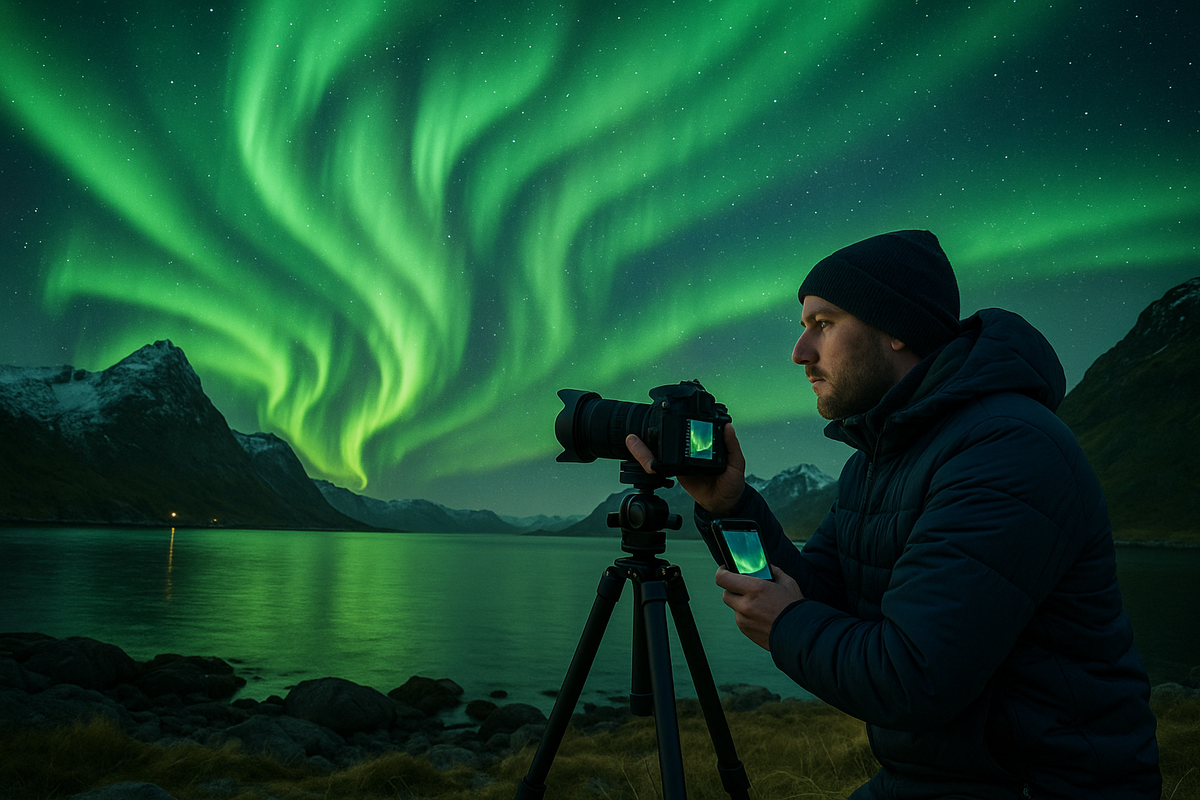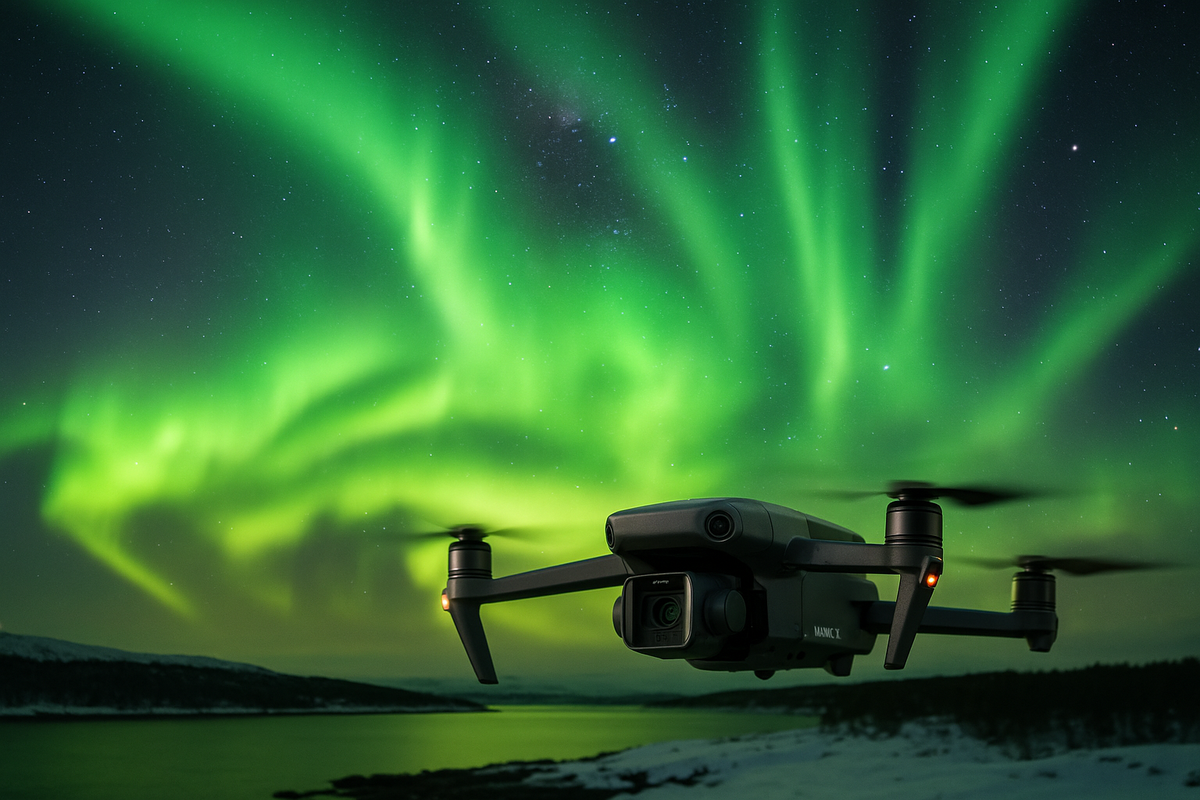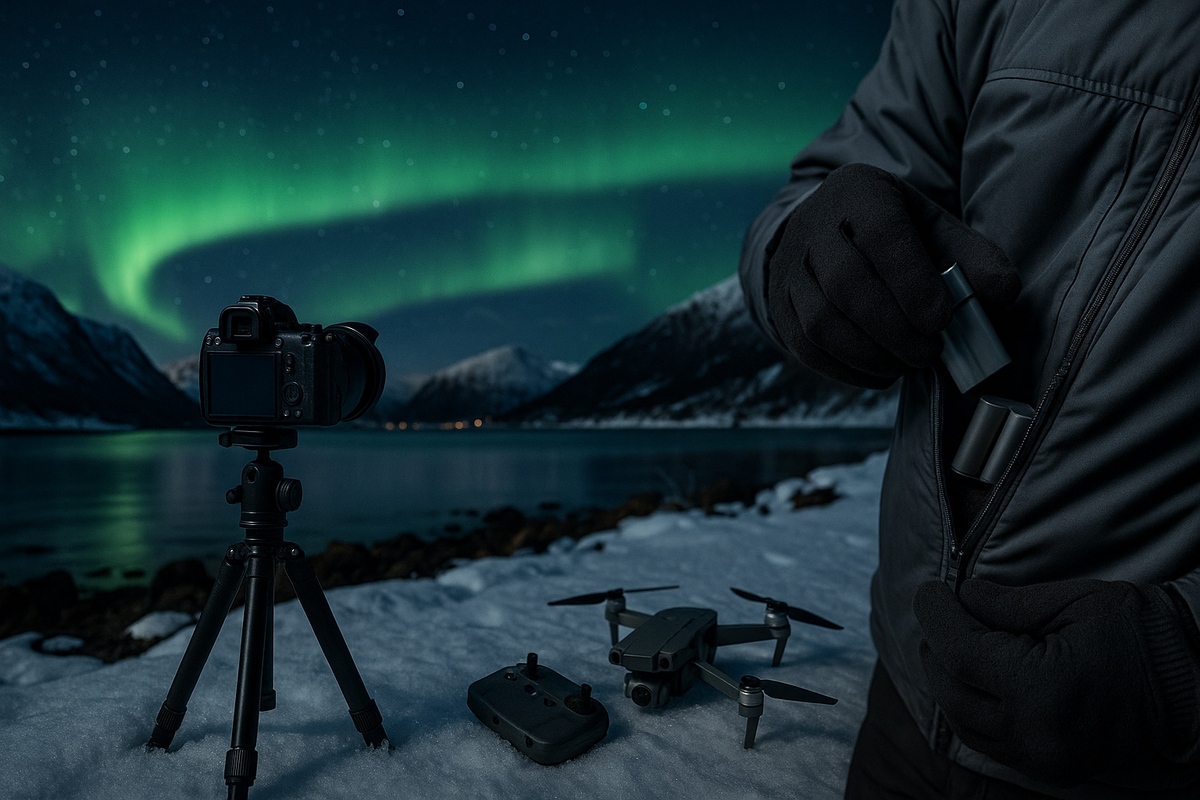📸🚁 Photography and video: capturing the Northern Lights with a camera and drone
At last, you've made it to the awe-inspiring beauty of Norway! The sky is awash with the incredible spectacle of the northern lights. So why not capture this moment in time with some professional-looking photos and videos? We're going to have so much fun figuring out how to properly photograph the aurora borealis with a camera and smartphone! We'll discover the perfect settings to use, including whether you can use drones in freezing temperatures and how to protect your equipment from rapid battery drain.
This article is jam-packed with practical tips and checklists to help you take absolutely perfect shots every time.

Ideal camera settings for photographing the Northern Lights
The amazing Northern Lights are so stunning that they require special settings to capture them at their best! Here is a step-by-step checklist to get you started:
📸 Aurora Camera Settings — Quick Sheet
| Setting | Value | Note |
|---|---|---|
| Camera mode | Manual (M) | Full control over all settings |
| ISO (sensitivity) | 800–3200 (start ≈ ISO 1600) | Brighter sky = lower ISO |
| Shutter speed | 5–25 s | Faster aurora = shorter exposure |
| Aperture (f) | f/2.8–f/4 (wide open) | Lets in more light → lower ISO |
📱 How to photograph the Northern Lights on a smartphone?
Amazingly, even a modern smartphone can capture the awe-inspiring spectacle of the northern lights! The most important thing is to use the right settings and keep the device steady.
- You can use night mode or download amazing special apps (like NightCap for iPhone or Camera FV-5 for Android).
- Secure your smartphone on a tripod or a stable surface and get ready to capture life as it happens!
- Here's a great tip: turn off the flash and autofocus, and set the focus to infinity!
- Get ready to capture the magical moment of the aurora dancing in the night sky! Set your camera to 5–20 seconds for the perfect shutter speed and 400–1600 for the ideal ISO. And remember, the brighter the aurora, the lower the ISO you'll need.
📌 Tip: Try the settings at home in the dark beforehand so you don't waste time during the observation.
🎥 Filming the aurora: is it possible?
Filming the awe-inspiring Northern Lights on video is a thrilling challenge, and it's absolutely possible, especially when the aurora is at its strongest:
- You're going to love the camera you use for this! Make sure it's got a high ISO and a fast lens (f/1.8–f/2.8).
- The best way to ensure your footage maintains its top-notch quality when you're editing is to shoot in 4K format!
- You're going to love the results if you keep the shutter speed as long as possible (e.g. 1/15–1/30 seconds) and the ISO as high as possible.
- The key to great photography is stability, so make sure your camera is firmly mounted on a tripod or stabiliser.
🚁 Can you shoot the Northern Lights with a drone?
It's a great idea to use a drone to take photos of the northern lights, but there are some challenges to consider.
- If you go out in temperatures below –10 °C, your battery will run out quickly.
- GPS can be unreliable during powerful geomagnetic storms.
- Stabilisation and night-time video recording require expensive drones (for example, the DJI Mavic 3, DJI Air 3 or DJI Mini 4 Pro).

Tips for using drones in cold weather:
- Make sure you keep batteries warm by carrying them in pockets or thermal boxes.
- Start the drone from a vehicle that has been heated to the right temperature first.
- Fly for short periods of time (5–15 minutes) and check how much battery charge you have left.
🔋 How to protect batteries from rapid discharge in cold weather?
The biggest problem for technology is low temperatures. Here are some easy steps to keep your batteries safe:
- Make sure you always keep spare batteries in pockets close to your body.
- Make sure you use thermal covers for batteries and power banks.
- Take extra batteries with you, in case your phone or camera battery runs out while you're out and about.
🖼️ Infographic: Top Tips for Northern Lights Composition
Great composition makes night photos unforgettable. Use these field-ready cues:
Rule of thirds
Place the brightest aurora band in the upper third; keep a clean horizon line.
Framing • BalanceUse a strong foreground
Mountains, cabins or trees anchor the scene and add depth and scale.
Depth • StoryHunt for reflections
Calm sea or fjords double the aurora—compose low to maximize the mirror.
Symmetry • ContrastAdd human silhouettes
Include a person at 1/3 or 2/3 to give scale and a focal point.
Scale • EmotionLight a small subject
Subtle light on a cabin/rock (headlamp or dim lamp) adds texture—avoid overpowering the sky.
Texture • Contrast🎒 Here is a checklist of the essential equipment you will need for your northern lights photography adventure!
✔️ Camera: DSLR or mirrorless camera with manual settings
✔️ Smartphone: with night mode or a special app
✔️ Tripod: stable and lightweight (essential!)
✔️ Remote shutter release: for camera stability
✔️ Spare batteries and power bank: at least 2–3
✔️ Wide-angle lens: (14–24 mm) ideal for landscapes
✔️ Flashlight or headlamp: for adjusting the camera in the dark
✔️ Touchscreen gloves: to keep your fingers warm
✔️ Thermos flask with a hot drink: to keep warm and patient!
❓ Do I need special glasses or filters to view the aurora?
The Northern Lights are safe to look at. You don't need special filters or glasses. The only other thing you might need are photo filters or polarising filters to get more artistic effects in your photos.
⚠️ Common mistakes when photographing the aurora (and how to avoid them):
● Blurry shots: use a tripod and remote shutter release.
● Overexposure: reduce the ISO or exposure time, check your photos.
● Incorrect focus: set the focus manually to infinity.
● Low battery: always take spare batteries and keep them warm.
🎯 Summary and key tips:
● Practise shooting in the dark at home beforehand.
● Use ISO settings of 800–3200 and a shutter speed of 5–25 seconds.
● Always keep spare batteries warm.
● Check your drones for frost resistance and short flights.

💬 Share your experience!
I would absolutely love to know what equipment you use to shoot the aurora – I'm super excited to find out! Did you manage to capture it on video or with a drone? We can't wait to hear your tips and questions in the comments!
We can't wait to share the very best of these with you in our next articles! 🌌





1 comment
Log in to leave a comment